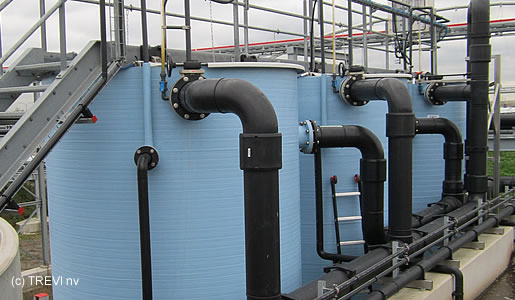Purpose
Removal of suspended solids
Removal of residual concentrations of heavy metals and organic substances
Principle
A sand filter retains suspended solids in two ways. Particles which are larger than the pores in the sand bed are retained by filtration, while smaller particles are adsorbed to the sand grains. While the sand bed is increasingly fouled, a filter cake with a smaller pore size is formed and helps to obtain a better separation.
Scheme
Application
There are a lot of examples of water containing too high concentrations of suspended solids. This could be effluent from a wastewater treatment plant which is discharged into surface water, reuse of process water, as well as surface water which is taken in as a source of supply water. Sand filtration proves to be the simplest technique to remove these suspended solids in an economical way.
Configuration
To prevent clogging, the sand filter has to be cleaned regularly. There are continuously and discontinuously cleaned sand filters. A discontinuous sand filter is stopped at regular intervals and flushed with air and water. This has the disadvantage that the filtering process is interrupted during the regeneration, except if a second sand filter has been installed. In the continuous sand filter operation, sand is constantly removed at the bottom of the sand filter, washed and circulated at the top of the sand filter.
Example of realisation

Three continuous open sand filters to polish the effluent of a biological WWTP
Approach Trevi
After physicochemical wastewater treatment or in case of relatively small flow rates Trevi will opt for discontinuous sand filters. For continuous processes such as a biological wastewater treatment plant or in the case of high flow rates a continuous sand filter is often the preferred option. This filter is preferentially fed by gravitation.
.jpg)